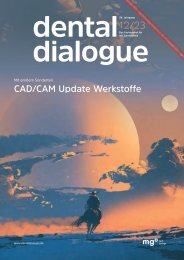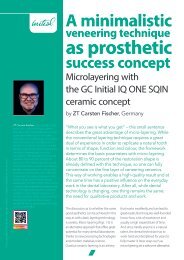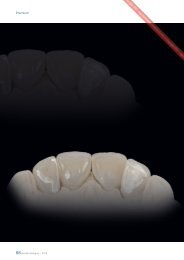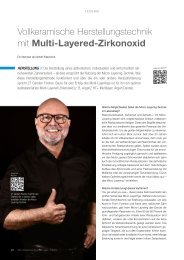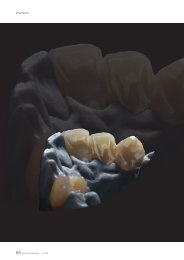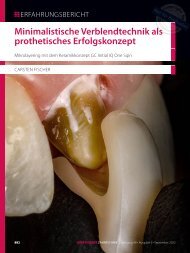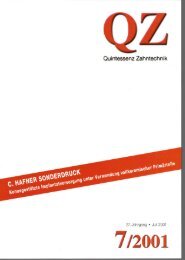Mikrobiologische Reinigung und Desinfektion Wirksamkeit einer dreistufigen Ultraschallbearbeitung Protokoll für CAD-CAM-Implantataufbauten
- No tags were found...
You also want an ePaper? Increase the reach of your titles
YUMPU automatically turns print PDFs into web optimized ePapers that Google loves.
The Journal of Advanced Prosthodontics<br />
https://doi.org/10.4047/jap.2022.14.5.273<br />
22 ± 2°C in a laminar air flow box. Three test abutments<br />
per group were ultrasonically cleaned and disinfected<br />
according to the procedure described above.<br />
One abutment per product type remained unprocessed<br />
and served as a positive control.<br />
The ultrasonically processed test abutments were<br />
eluted into tryptic soy broth (TSB). It consists of 3.0%<br />
polysorbate 80, 3.0% saponine, 0.1% histidine, and<br />
0.1% cysteine. The elution volume was 10 ml. The test<br />
samples were eluted in 10 ml of elution solution in a<br />
15 ml tube on a rotary shaker for 10 min at 300 rpm.<br />
Glass beads were added for better recovery of the test<br />
soils.<br />
Dilutions were prepared from the positive controls<br />
using a dilution solution of 0.1% tryptone and 0.85%<br />
sodium chloride and spread to tryptic soy agar (TSA).<br />
From each of the processed samples, 1.0 and 0.1 ml<br />
of the eluate were plated onto TSA. All samples were<br />
incubated at 36 ± 1°C for seven days. The grown colonies<br />
were counted visually and the determined germ<br />
counts were expressed as the decadal logarithm (lg)<br />
of the colony-forming units (CFU). The remaining elution<br />
volume was incubated for 7 days at 37°C to allow<br />
growth of pre-damaged test bacteria that were not<br />
completely killed (enrichment). Over the course of<br />
the 7 days, this was visible as turbidity of the sample<br />
and assessed with a detected colony count of < 10 (resulting<br />
in a logarithmic value of < 1), in case no residual<br />
germs could be detected on the culture medium.<br />
To evaluate the disinfection efficacy of the three-step<br />
cleaning protocol, the microbial load of the test abutments<br />
was subtracted from the microbial load of the<br />
positive controls, i.e., the reduction factor (RF) was<br />
calculated according to the following formula: RF = lg<br />
CFU/positive control - lg CFU/test specimens. The criterion<br />
for acceptance was a reduction of the test organism<br />
(bacteria) by ≥ 5 lg steps.<br />
RESULTS<br />
All test abutments (type I-IV) passed the qualitative-visual<br />
inspection with a magnifying glass at 400<br />
× magnification for cleanliness after being subjected<br />
to the three-stage cleaning procedure. The prerequisite<br />
for determining the amount of residual protein<br />
was thus met for all test specimens.<br />
For the uncleaned one-piece zirconia abutment<br />
(positive control type I), a protein concentration of<br />
670.55 µg bovine serum albumine (BSA) was detected<br />
in the 1:1.25 diluted eluate by modified OPA analysis,<br />
whereas after ultrasonic cleaning, protein was not detectable<br />
in the <strong>und</strong>iluted eluate for any of the three<br />
test type I specimens examined, and the depletion<br />
was ≥99.99% (Table 2). The one-piece titanium test<br />
abutments (type IV) exhibited a similar high cleaning<br />
efficacy based on the initial BSA of 1492.15 µg for the<br />
positive control (Table 2). In both two-piece hybrid<br />
abutments (type II, type III), minimal traces of BSA<br />
were present in the serum after cleaning. The protein<br />
concentration was a maximum of 1.83 µg BSA for lithium<br />
disilicate hybrid abutments (type II) (Table 2) and<br />
67.74 µg BSA for zirconia hybrid abutments (type III)<br />
(Table 2). However, the extent of depletion was over<br />
95% for type III abutments and over 99% for type<br />
II abutments. As a result, the test requirements for<br />
cleanliness for all investigated one-piece- and twopiece<br />
abutments were successfully met (reference<br />
value: ≤ 80 µg residual protein quantity per sample).<br />
31 The limit of detection was 3.9 µg/ml, resulting<br />
in a limit of quantification of 19.5 µg/sample.<br />
DISCUSSION<br />
Recent in vitro studies have detected contaminants<br />
on the surfaces of titanium and zirconia <strong>CAD</strong>-<strong>CAM</strong> customized<br />
implant abutments from various manufacturers.<br />
8-10 All tested specimens exhibited process-related<br />
roughening, micro wear deposits, and organic<br />
and inorganic debris upon delivery. These contaminants<br />
can be caused by machining residues, coolant<br />
or chemical washing protocols after industrial milling<br />
as a remnant of surface processing in centralized<br />
production. The fabrication of <strong>CAD</strong>-<strong>CAM</strong> abutments<br />
in the dental laboratory is basically subject to the<br />
same sources of contamination. In addition, the risk<br />
of remaining blasting media, excess adhesive, hand<br />
grease, polishing agents and rubber residues must<br />
be taken into account. 9,33 Soft tissues surro<strong>und</strong>ing<br />
implants are hypovascular and hypocellular scar tissues<br />
with a considerably lower immunologic capacity<br />
than periodontal tissues aro<strong>und</strong> teeth. 12,34 If not<br />
removed, these particulate contaminants can have<br />
278 https://jap.or.kr



